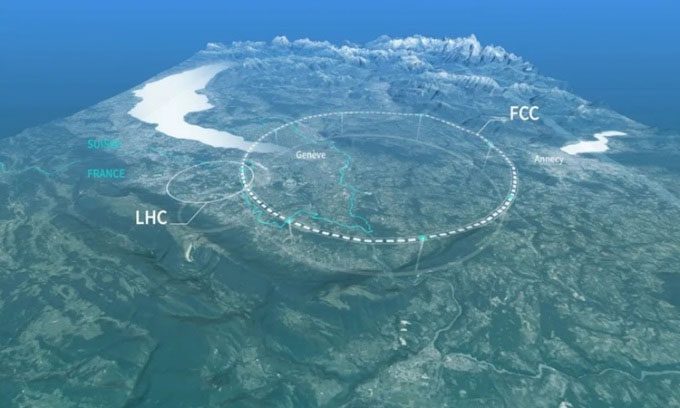The $17 Billion Particle Accelerator Proposed by CERN Aims to Discover New Particles and Forces, Unraveling Dark Matter and Energy.
Researchers at CERN (European Organization for Nuclear Research) have proposed the construction of a new, larger particle accelerator. The Future Circular Collider (FCC), valued at $17 billion, will stretch 91 km, far exceeding its predecessor, the Large Hadron Collider (LHC), which is 27 km long and located at CERN near Geneva, as reported by Live Science on February 10.

Size comparison of FCC to LHC. (Photo: CERN).
Physicists hope to utilize the increased size and power of the FCC to probe the boundaries of the Standard Model of particle physics, the best current hypothesis that describes how the universe’s smallest components operate. By allowing particles to collide at much higher energy levels (100 tera-electron volts compared to 14 at the LHC), the research team aims to uncover many new types of particles and forces, explore why matter is heavier than antimatter, and investigate the nature of dark matter and dark energy, two invisible entities believed to constitute 95% of the universe.
“The FCC will not only be a remarkable tool to enhance our understanding of the fundamental laws of physics and nature,” said Fabiola Gianotti, CERN’s Director-General. “It will also drive innovation, as we will need more advanced technologies, from cryogenics to superconducting magnets, vacuum technology, detectors, instrumentation research, and technologies with the potential for significant societal impact and economic benefits.”
Particle accelerators like the LHC collide protons at speeds approaching the speed of light, while searching for rare decay products that could provide evidence of new particles or forces. This helps physicists test their understanding of the most fundamental building blocks of the universe and how they interact, as described by the Standard Model of physics.
Although the Standard Model has allowed scientists to make many notable predictions, such as the existence of the Higgs boson, discovered by the LHC in 2012, the physics community remains unsatisfied and continuously seeks new physics models that can surpass it. Despite being the most comprehensive model to date, it still contains several major gaps, leaving it unable to fully explain the origin of gravity, what dark matter is made of, or why there is more matter than antimatter in the universe.
To decipher these issues, physicists at CERN will use the FCC’s sevenfold higher beam energy to accelerate particles to faster speeds. Although a promising advancement, this detector has yet to be constructed. The proposal put forth by CERN is part of a preliminary feasibility study report expected to be completed next year.
Once completed, and if the detector project progresses, CERN, which is operated by 18 member countries of the European Union, as well as Switzerland, Norway, Serbia, Israel, and the United Kingdom, will seek additional funding for the project from other nations.
Member countries will meet in 2028 to decide whether to approve the project. Subsequently, the first phase of the machine, which involves electron collisions with their antiparticle, positron, is expected to become operational by 2045. Ultimately, in the 2070s, the FCC will begin proton collisions.


















































